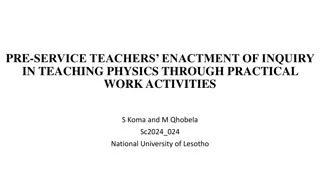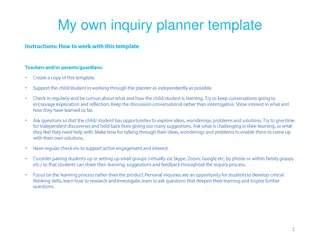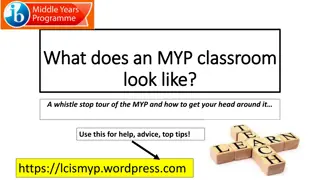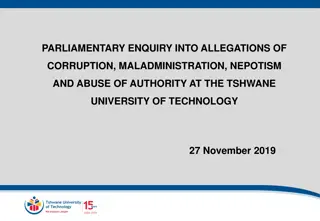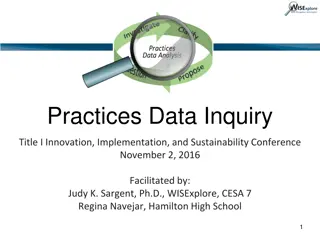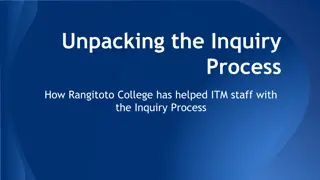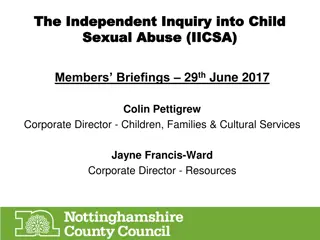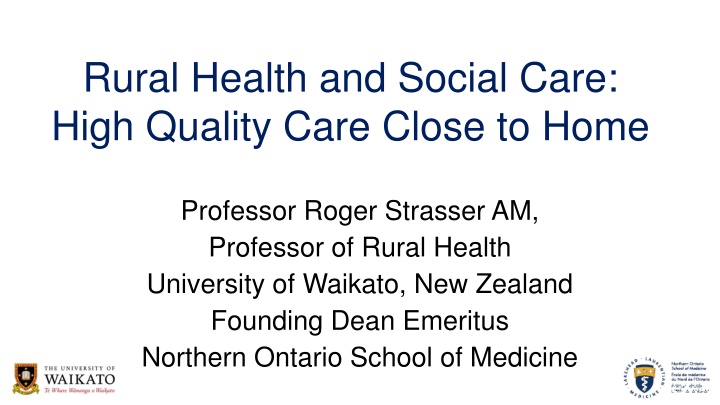
Rural Health and Social Care Insights: Strategies for Quality Services
Discover the challenges and solutions in rural health and social care, including workforce shortages, service delivery models, and interprofessional teamwork. Learn about recruitment facilitators, workforce stability frameworks, and the importance of addressing population service needs for tailored care.
Download Presentation

Please find below an Image/Link to download the presentation.
The content on the website is provided AS IS for your information and personal use only. It may not be sold, licensed, or shared on other websites without obtaining consent from the author. If you encounter any issues during the download, it is possible that the publisher has removed the file from their server.
You are allowed to download the files provided on this website for personal or commercial use, subject to the condition that they are used lawfully. All files are the property of their respective owners.
The content on the website is provided AS IS for your information and personal use only. It may not be sold, licensed, or shared on other websites without obtaining consent from the author.
E N D
Presentation Transcript
Rural Health and Social Care: High Quality Care Close to Home Professor Roger Strasser AM, Professor of Rural Health University of Waikato, New Zealand Founding Dean Emeritus Northern Ontario School of Medicine
Rural Health Around the World access is the rural health issue resources concentrated in cities communication and transport difficulties rural health workforce shortages
Rural Practitioners Extended Generalists wide range of services high level of clinical responsibility relative professional isolation specific community health role
Rural Health Care Delivery different from cities local services preferred not assume patients will travel specialists support role partnership not putdown consultant support local service
Interprofessional Teamwork Much talked about in the cities Actually happens more in rural communities - workforce shortages - community relationship - responding to community needs
Recruitment Facilitators for Rural Practice rural upbringing positive undergraduate rural clinical & educational experiences targeted postgraduate training for rural practice
Underpinnings of the Framework Taking the long view is essential Strike a balance urgent vs long view - inter-sectoral investment in training and career promotion - create a desirable workplace - transient workers to make a longer-term commitment to your region
Plan Assess Population Service Needs - specific health needs vary from community to community and over time Align the Service Model with Population Needs - model designed in and for community, not imported from city Develop a Profile of Target Recruits - identify required mix and skills of providers for the service model
Recruit Emphasize Information Sharing - all about the professional, personal/family and social aspects of the work Community Engagement - active community participation is essential to successful recruitment Supporting Spouses / Families - the whole family has to feel welcome and at home in the community
Retain Supporting Team Cohesion - friendly, supportive work environment with accessible specialist support Relevant Professional Development - local team learning, on-line and funded travel to keep up-to-date Training Future Professionals - learning in remote rural settings improves retention and provides future recruits
Conditions for Success Recognition of unique rural and remote issues Inclusion of remote rural engagement & perspectives Targeted investment An annual cycle of activities Monitoring and evaluation
Social Accountability building accountability that relies on civic engagement, in which citizens participate directly or indirectly in demanding accountability from service providers and public officials World Bank, 2009 Social Accountability of medical schools is the obligation to direct education, research and service activities towards addressing the priority health concerns of the community, region and/or nation they have a mandate to serve WHO, 1995
Partnership Pentagram Policy makers People s health needs Health professionals Health Managers Communities Academic institutions
Conclusion Commonalities - remote rural communities have much in common even across international boundaries Transience - recruit workers who make a longer-term commitment to your region to assure continuity and quality Education and Training - training of local remote rural people, in remote rural locations, for remote rural jobs leads to successful recruitment and stability of remote rural services Community Engagement - active community participation is essential to successful stable remote rural health services
References Strasser R. Rural Health Around the World: Challenges and Solutions. Family Practice. 2003; 20: 457-463. Strasser R. Learning in Context: Education for Remote Rural Health Care. Rural and Remote Health. 2016; 16: 4033. Strasser R. Recruiting and retaining a rural medical workforce: the value of active community participation. (Guest Editorial) Med J Aust. 2017; 207: 154-158. Strasser R, et al. Community engagement: A central feature of NOSM s socially accountable distributed medical education. CMEJ 2018; 9(1): e33-e43 Strasser R, Mitchell D, Logozzo J, Preston P, Walker N. Challenges of Capacity and Development for Health System Sustainability. Healthcare Papers 2018, 17(3): 18-27. Abelsen B, Strasser R, et al. Plan, Recruit, Retain: A Framework for Remote Rural Workforce Stability. Human Resources for Health. 2020; 18: 63.




